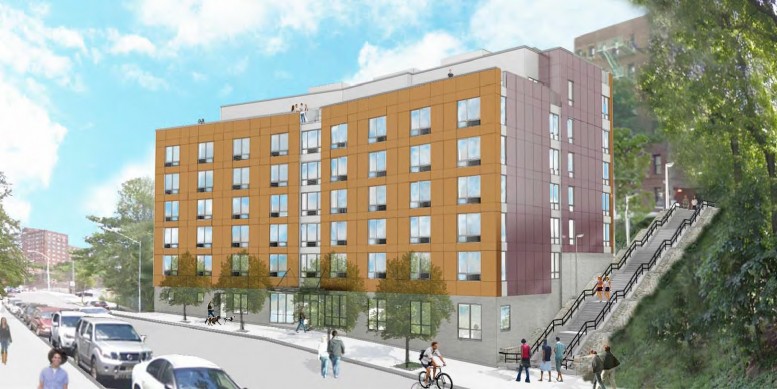The South Bronx continues to boom with new affordable and supportive housing projects. Non-profit Services for the Underserved hopes to build a seven-story apartment building at 1434 Undercliff Avenue, in the Highbridge section of the Bronx.
The development would have 75 apartments, which will break down into 65 studios and nine two-bedrooms, plus the super’s apartment. They’ll be spread across 49,143 square feet, for average, 655-square-foot units.
Sixty percent of the apartments will be supportive housing, but the type of tenants who live there depends on the federal and state grants SUS receives during construction. The supportive units could house people struggling with mental health issues, drug addiction, or HIV/AIDS. The remaining 40 percent will rent to tenants who make no more than 60 percent of the Area Median Income, or $43,500 for a two-person family. Part of the development will be reserved for veterans, because the organization has already nailed down that piece of the funding.
Offices for supportive services, like a social worker, case manager, and job counselor, would occupy most of the first floor. There would be nine units on the second floor, followed by 16 units each on the third through sixth floors. The seventh floor would host two apartments, a computer room, a lounge with a small kitchen, and a roof deck with a garden. SUS also hopes to put solar panels on the roof.
No parking is included, because the city’s new zoning changes waived parking for affordable and supportive projects within a mile of the subway.
James McCullar Architecture will be responsible for the design. McCullar also worked on SUS’s last project, a seven-story mix of supportive and affordable housing on Third Avenue in Morrisania. The 51-unit development was built using modular construction, with apartments assembled by Capsys at the Brooklyn Navy Yard. Capsys is closing up shop this month after 20 years at the Navy Yard, and 1434 Undercliff Avenue will be built with typical block-and-plank construction.
Like much of the western Bronx, the development site sits on a rocky, steep slope. Since digging into the cliff is difficult and expensive, the building won’t have a basement. However, the back of the structure will sit on the top of the cliff, several feet above the street level entrance to the building.
Construction is scheduled to begin in June and finish sometime in 2018.
Subscribe to the YIMBY newsletter for weekly updates on New York’s top projects
Subscribe to YIMBY’s daily e-mail
Follow YIMBYgram for real-time photo updates
Like YIMBY on Facebook
Follow YIMBY’s Twitter for the latest in YIMBYnews






More saturation continues of these type of “services” in the south and west Bronx. The excuse now is that “oh well the land is cheaper”. Well yeah after the city allowed it to fall apart in the 60’s and 70’s. Then again – I guess that was the strategy all along.
Your reference to the 60’s and 70’s and a strategy was actual urban planning policy adopted during the Lindsay administration. It was called “Planned Shrinkage,” as advocated by a man named Roger Starr. In The Bronx the plan called for saturating everything south of Fordham Road with the city’s most desperate people and then withdrawing all but the most essential services as provided by the City to these communities. The result is history, but what is often not realized is that between 1970 and 1980 over 60,000 apartments were intentionally set on fire by property owners and the borough’s population declined by 303,000 within ten years. Even more amazing, this decline (approximately 30%) happened only south of Fordham Road. So today I often ask, does the City of New York have a vested interest in keeping The Bronx poor?
Yes I’m aware and that is exactly what I was talking about. South of Fordham became the “release valve” for east and central Harlem.
In my opinion the city still wants to keep that part of the Bronx poor as Harlem and Washington Heights become more expensive. In the same way they want to keep Brownsville and ENY poor in Brooklyn as “gentrification” moves in to even Bed Stuy from the waterfront. Meanwhile they are closing down support services for the downtrodden in Manhattan. They push the poor – and people with social issues into The South Bronx and Eastern Brooklyn. It’s ok for that to happen while the Bowery and Hells Kitchen (do new transplants even know what they looked like?) and the Lower East Side become nice – since they are Manhattan. Same with Bushwick and Red Hook in Brooklyn. All that does is continue to concentrate poverty. Same goal as before – just different methods. It’s done with a smile now. While the media pretends to be blind.
Hillsides are quite steep in this area, and rock prevents excavation into them.
As a child I lived at 166th and Jerome Avenue, with staircase next to our building going up to next street level. At one time there was a spur elevated rail line going through a tunnel through the hill, and over the Harlem River, to the Polo Grounds stadium. Torn down years ago, but the tunnel is still there.
I’ve been wondering if that tunnel was still accessible! The concrete platforms for the Sedgwick stop are still there too.
1501 was the first building just beyond (North Of) the Cross Bronx Expressway. I wonder if this would be located south of the Washington Bridge? South of Boscobel Place?
yes, south of the bridge and just south of Boscobel Place